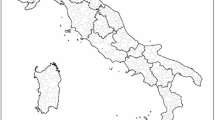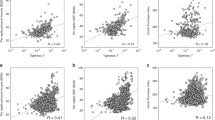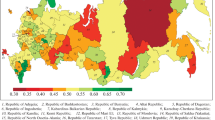Abstract
In this paper, we evaluate Spanish regions’ resistance to the economic crisis under three main resilience notions: “adaptative,” “engineering” and “ecological.” “Adaptative” resilience is measured through a traditional shift-share approach applied to employment, whereas “engineering” and “ecological” resilience pay attention to growth path and total employment level, in the pre- and post-crisis period. The paper presents an application of the different notion of resilience to the case of Spanish provinces in the last years. We find that provinces with sectoral structure and location advantages, or those with locational advantages in the post-crisis period (according to the “adaptative” resilience measure), exhibit a significantly lower “drop” in growth (according to the “engineering” and “ecological” resilience measure). Furthermore, we conclude that the probability of presenting a better behavior (lower “drop” in growth than the average) increases for those regions specialized in the service sector before the crisis. As expected, the worse behavior has correspond to those regions specialized in the pre-crisis period in the construction sector.
Similar content being viewed by others
Notes
“Ecological” resilience is related to evolutionary theories, which consider the region as the result of social interactions subject to a process of transition, and time is considered a flow.
Nevertheless, our counterfactual predictions are obtained through a different process that is proposed in Fingleton and Palombi (2013).
They are represented as dotted lines in graphs in Fig. 1.
The demeaning equation is obtained by taking each variable in the regression equation in deviation from its average over time, for instance for the endogenous variable: \(y_{\mathrm{rt}}^*=y_{\mathrm{rt}} -\frac{\sum \nolimits _{t=1}^T {y_{\mathrm{rt}}}}{T}\).
We have excluded the Spanish autonomous cities of Ceuta and Melilla.
Such a breakpoint has also been confirmed through the calculation of successive F-Chow tests applied to the proposed models for all possible time periods.
In fact, the correlation coefficient among periods for each sector is the following: (1) agriculture: 0.9644; (2) industry: 0.8984; (3) construction: 0.4307; and (4) services: 0.9561.
Several studies have analyzed the consequences of sparser/denser matrix (see for instance Smith (2009)). Moreover, our results are consistent with other W matrices specified on the basis of the inverse of the distance between centroids in the provinces or the inverse of the square of such distances. Matrices based on the contiguity criteria have been discarded since we assume that (following Zeilstra and Elhorst (2014)), interaction in employment markets is determined, mainly, by distance.
References
Anderson TW, Hsiao C (1981) Estimation of dynamic models with error components. J Am Stat Assoc 76:598–606
Angulo A, Trívez FJ (2010) The impact of spatial elements on the forecasting of Spanish labour series. J Geogr Syst 12:155–174
Anselin L (1988) Spatial econometrics: methods and models. Kluwer, Dordrecht
Anselin L (2007) Spatial econometrics. In: Mills TC, Patterson K (eds) Handbook of econometrics, vol 1. Palgrave, Basingstoke, pp 901–969
Arellano M, Bond S (1991) Some tests of specification for panel data: Monte Carlo evidence and application to employment equations. Rev Econ Stud 58:277–297
Arellano M, Bover O (1995) Another look at the instrumental-variable estimation of error-components models. J Econ 68:29–51
Augustine N, Wolman H, Wial H, McMillen M (2013) Regional economic capacity, economic shocks and economic resilience. MacArthur foundation network on building resilient regions, Working Paper
Baltagi BH (2005) Econometric analysis of panel data, 3rd edn. Wiley, Chichester
Baltagi BH, Li D (2004) Prediction in the panel data model with spatial correlation. In: Anselin L, Florax RJGM, Rey S (eds) Advanced in spatial econometrics: methodology, tools and application. Springer, Heidelberg, pp 283–295
Baltagi BH, Li D (2006) Prediction in the panel data model with spatial correlation: the case of liquor. Spat Econ Anal 1(2):175–185
Baltagi BH, Bresson G, Pirotte A (2012) Forecasting with spatial panel data. Comput Stat Data Anal 56:3381–3397
Blundell R, Bond S (1998) Initial conditions and moment restrictions in dynamic panel data models. J Econ 87:115–143
Bun M, Carree M (2005) Bias-corrected estimation in dynamic panel data models. J Bus Econ Stat 3(2):200–210(11)
Cliff AD, Ord JK (1973) Spatial autocorrelation. Pion Ltd., London
Cuadrado-Roura JR, Maroto A (2016) Unbalanced regional resilience to the economic crisis in Spain: a tale of specialisation and productivity. Camb J Reg Econ Soc 9(1):153–178
Doran J, Fingelton B (2013) US Metropolitan area resilience: insights from dynamic spatial panel estimation. Paper presented at the annual conference of the regional science association international (British and Irish Section). University of Cambridge
Esteban J (1972) A reinterpretation of shift-share analysis. Reg Urban Econ 2:249–261
Evans R, Karecha J (2013) Staying on top: Why is Munich so resilient and successful? Eur Plan Stud. doi:10.1080/09654313.2013.778958
Fingleton B, Garretsen H, Martin R (2012) Recessionary shocks and regional employment. J Reg Sci 52(1):109–133
Fingleton B, Palombi S (2013) Spatial panel data estimation, counterfactual predictions and local economic resilience among British towns in the Victorian era. Reg Sci Urban Econ 43:649–660
Foster KA (2007) A case study approach to understanding regional resilience. Working Paper 2007–2008. Institute of Urban and Regional Development, Berkeley
Hahn J, Kuersteiner G (2002) Asymptotically unbiased inference for a dynamic panel model with fixed effects when both \(n\) and \(T\) are Large. Econometrica 70(4):1639–1657
Hill E, Wial H, Wolman H (2008) Exploring regional economic resilience. Working paper 2008 (4). Institute Urban and Regional Development, Berkeley, UC
Holling CS (1973) Resilience and stability of ecological systems. Ann Rev Ecol Syst 4:1–23
Holling CS (1996) Engineering resilience versus ecological resilience. In: Schulze P (ed) Engineering within ecological constraints. National Academy Press, Washington, DC, pp 31–44
Holling CS (2001) Understanding the complexity of economic, ecological and social systems. Ecosystems 4:390–405
Hsiao C (2003) Analysis of panel data, 2nd edn. Cambridge University Press, Cambridge
Hsiao C, Pesaran MH, Tahmiscioglu AK (2002) Maximum likelihood estimation of fixed effects dynamic panel data models covering short time periods. J Econ 109:107–150
Instituto Nacional de Estadística, INE (several years). Encuesta de población activa, Madrid
Kholodilin KA, Siliverstovs B, Kooths S (2008) A dynamic panel data approach to the forecasting of the GDP of German Länder. Spat Econ Anal 3(2):195–207
Kiviet J (1995) On bias, inconsistency, and efficiency of various estimators in dynamic panel data models. J Econ 68:81–126
Longhi S, Nijkamp P (2007) Forecasting regional labor market developments under spatial heterogeneity and spatial correlation. Int Reg Sci Rev 30:100–119
Martin R (2012) Regional economic resilience, hysteresis and recessionary shocks. J Econ Geogr 12:1–32
Martin RL, Sunley P (2015) On the notion of regional economic resilience: conceptualization and explanation. J Econ Geogr 15:1–42
McGlade J, Murray R, Baldwin J, Ridgway K, Winder B (2006) Industrial resilience and decline: a co-evolutionary framework. In: Garnsey E, McGlade J (eds) Complexity and co-evolution: continuity and change in socio-economic systems. Edward Elgar, Cheltenham, pp 147–176
Modica M, Reggiani A (2015) Spatial economic resilience: overview and perspectives. Netw Spat Econ 15:211–233
Nickell SJ (1981) Biases in dynamic models with fixed effects. Econometrica 49:1417–1426
Romer R (2001) Advanced macroeconomics. McGraw Hill, New York
Sevestre P, Trognon A (1996) Dynamic linear models. In: Mátyás L, Sevestre P (eds) The econometrics of panel data, 2nd edn. Kluwer, Dordrecht
Smith T (2009) Estimation bias in spatial models with strongly connected weight matrices. Geogr Anal 41:307–332
Walker B, Gunderson L, Kinzig A, Folke C, Carpenter S, Schultz L (2006) A handful of heuristics and some propositions for understanding resilience in socio-ecological systems. Ecology and Society, 11. http://www.ecologyandsociety.org/vol11/iss1/art13/. Accessed 1 Dec 2010
Yu J, de Jong R, Lee LF (2008) Quasi-maximum likelihood estimators for spatial dynamic panel data with fixed effects when both \(N\) and \(T\) are large. J Econ 146:118–134
Zeilstra J, Elhorst P (2014) Integrated analysis of regional and national unemployment differentials in the European Union. Reg Stud 48:1739–1755
Acknowledgements
The authors are grateful for the financial support of the Spanish Government’s Ministry of Economy and Competitiveness (ECO2015-65758-P), as well as for the financial support of the Department of Industry and Innovation of Aragon Government and the European Fund of Regional Development through the GAEC group.
Author information
Authors and Affiliations
Corresponding author
Rights and permissions
About this article
Cite this article
Angulo, A.M., Mur, J. & Trívez, F.J. Measuring resilience to economic shocks: an application to Spain. Ann Reg Sci 60, 349–373 (2018). https://doi.org/10.1007/s00168-017-0815-8
Received:
Accepted:
Published:
Issue Date:
DOI: https://doi.org/10.1007/s00168-017-0815-8














